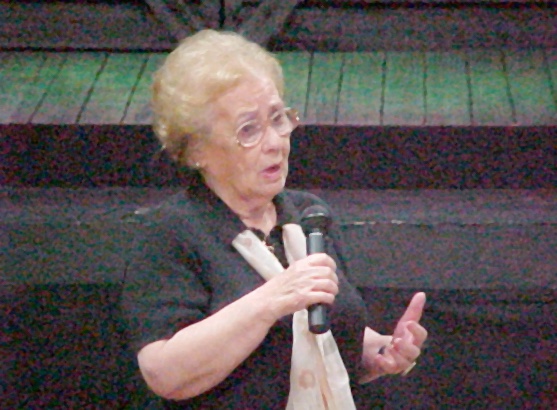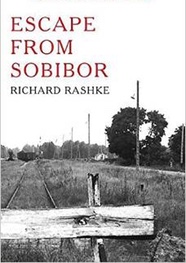The Woman Who Liberated Herself from Sobibor

I met Esther Raab for the first time in 1981 during an International Liberators Conference sponsored by the U.S. Department of State. Medal-chested soldiers from fourteen countries had gathered in Washington, D.C., my hometown, for the special two-day remembrance. But I didn’t attend the conference to learn how they had liberated Nazi camps across Europe and what horrors they had seen.
 I came to see Esther who had liberated herself in 1943
from Sobibor, a death camp in German-occupied Eastern Poland.
I came to see Esther who had liberated herself in 1943
from Sobibor, a death camp in German-occupied Eastern Poland.
Esther had agreed to give a short talk about the prisoner revolt at Sobibor in October 1943 during a conference workshop on “Uprisings.” It would be her first major public appearance as a Holocaust survivor-witness, the beginning of a new phase in her life and a new chapter in mine.
When Esther stood to deliver her prepared speech, her hands shook, her face muscles tightened, and her lips trembled. I had taught public speaking at a Pennsylvania high school for five years and knew stage fright when I saw it. But that afternoon, I misidentified what I was seeing. Esther wasn’t terrified at the thought of standing in front of an audience. She wasn’t really in the room that day. She was back in Sobibor. Afraid of Nazis. Seething with rage. Hungering for revenge. Clinging to a fragile thread of hope. As she stood in that State Department conference room facing her survivor-peers, she didn’t know if she would sob, scream, sit back down, or run out of the room.
I had already seen what “going back to Sobibor” did to survivors more than a dozen times during my interviews in the U.S., Brazil, Poland, Israel, and the Soviet Union. To distance themselves from Sobibor, most of the survivors had learned to stand outside their bodies and watch the person who was acting as themselves Every now and then the distancing technique failed and memory broke through their protective wall. Sometimes the pain was so acute, they couldn’t contain it.
That afternoon in 1981, as Esther recounted her escape from Sobibor, she didn’t cry or scream, or run. She finished her talk to a round of polite applause and quietly sat down After the workshop, I introduced myself and told her I was writing a book called Escape From Sobibor. I needed help. Could I visit her at her home in Vineland, New Jersey, and hear her story?
For hours at her kitchen table, she talked and I listened. Then she talked some more the next day. I found her memory of the death camp graphic in its specificity. Her story was not only compelling but miraculously defied the odds of surviving Nazis, anti-Semitic Poles, and the wages of World War II.
Over the next several months, I came to rely on Esther’s memory and instincts as I struggled to weave nineteen interviews with Sobibor survivors into a cohesive story. Esther became my essential sounding board and fact checker.
When my book finally came out, Esther was a fierce promoter, proud of her contribution that no one but I—and a few perceptive readers—could see. When Marstar Productions asked for the movie rights to the book, I agreed to grant them on one condition—it had to hire Esther as its survivor-consultant. Esther gladly agreed to serve as a film consultant, but wouldn’t take a dime. Marstar told her that she had to accept something to make the deal legal. Esther told them to write a check for one dollar. She never cashed it.
The movie, shot in a camp constructed in a forest in Slovenia, ended up having a huge impact on Esther’s future. While the tall, skinny actor who played her in the film didn’t resemble her in the least, and more of her story ended up on the cutting room floor than on the screen, it was the crawl at the end of the movie that changed her life one final time. The viewing audience came to see that Esther Terner Raab had survived the rest of the war in a barn, eventually emigrated to the United States, and was now living in New Jersey.
Public school students who watched Escape From Sobibor as part of New Jersey’s Holocaust education program began seeking her out. For more than twenty years she accepted invitations to screenings of the film and would stay afterwards to talk about it. She told me that after every discussion or interview, she couldn’t sleep for days.
When I suggested the idea of weaving into a play some of the thousands of letters she had received from students who saw the movie and heard her speak afterwards, she agreed to cooperate. And yet she declined to read the final draft.
“I trust you,” she said.
Dear Esther, it turned out, caused Esther Raab intense pain. In my interviews with her while I was developing the script, she told me she had not cried since Sobibor. “First, the Nazis took our laughter,” she said. “Then they stole our tears. In Dear Esther she says, “There is no escape from Sobibor. Not for me. Not for Germany. Not for Poland. Not for the world. Not even God can escape from Sobibor.”
Well, my dear Esther, at the age of ninety-two, you have finally escaped from Sobibor. May you now rest in peace, in the bosom of Abraham.
Copyright © Richard Rashke 2015